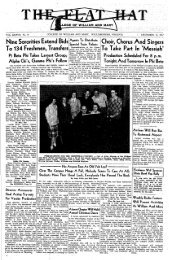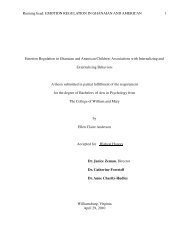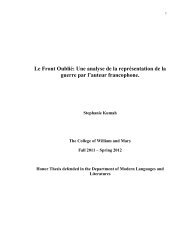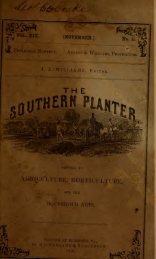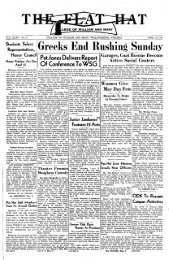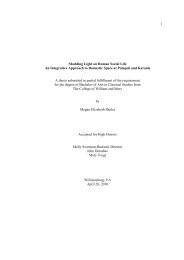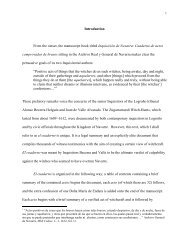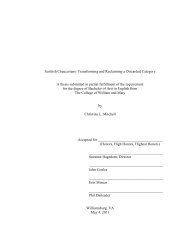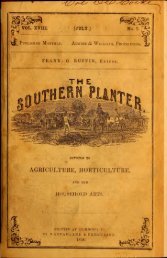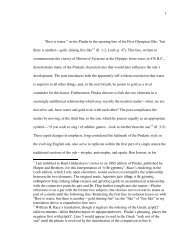Southern planter - The W&M Digital Archive
Southern planter - The W&M Digital Archive
Southern planter - The W&M Digital Archive
You also want an ePaper? Increase the reach of your titles
YUMPU automatically turns print PDFs into web optimized ePapers that Google loves.
859.] THE SOUTHERN PLANTER. 403<br />
<strong>The</strong> breadth of land iii the United States,<br />
uited to the wheat crop, is comparatively<br />
mall, and in the older States would appear<br />
o be diminishing.<br />
In New England the culture of wheat is<br />
apidly declining; in the Middle States it<br />
3 nearly stationary, the increase for the ten<br />
ears previous to 1850 being only about 15<br />
er cent. In the North-Western States its<br />
ulture has rapidly increased ; and it is from<br />
his district that the largest supplies for ex-<br />
ort are derived.<br />
Chicago, which, twenty years ago imorted<br />
flour and meal for her own consumpion,<br />
has established brands of flour, which<br />
re now recognised throughout Europe ; and<br />
he is shown by recent statistics to be the<br />
irgest primary grain depot in the world,<br />
ivaling Odessa and Galatz, Dantziz and St.<br />
^tersburg, while she leads all other ports<br />
f the world also in the quantity and quality<br />
f her exports.<br />
<strong>The</strong> population of Chicago, which, in<br />
850, was 29,000, in 1856 had increased to<br />
04,00.0*<br />
<strong>The</strong> Census of New York, for 1855,<br />
hows that her wheat crop, once so famous,<br />
3 actually decreasing, owing, as it is sup-<br />
•osed, in part to the ravages of insects, and<br />
a part to diseases of the plant, assisted, per-<br />
laps, by a gradual deterioration of the soil.<br />
<strong>The</strong> wheat crop in New York was twelve<br />
aillions (12,286,418) in 1840, and only<br />
line millions (9,092,402) in 1855, a derease<br />
of twenty-five per cent., while the<br />
rop of Indian Corn, in the same State,<br />
Qcreased during the same period from about<br />
en (10,972,286) to twenty millions (19,-<br />
199,691), or nearly one hundred per cent.,<br />
howing, when taken together, not a dimi-<br />
lution in the bread crop of the State, for<br />
he joint increase is five millions of bushels,<br />
* <strong>The</strong> shipment of grain in 1855, was 2,200,-<br />
00 quarters, (of 8 bushels each,) being the<br />
irgest quantity ever shipped from anyone port<br />
Llhe world; 77.000 barrels of pork ; 56,000 barsis<br />
of beef. A direct trade between Chicago<br />
nd Liverpool, via the St. Lawrence, without<br />
anshipment. was successfully opened in 1856.<br />
y the Dean Richmond, a schooner of 380 tons<br />
agister, drawing 9| feet, with 400 tons of wheat<br />
le was the largest sized vessel that could come<br />
irough the canal, but it is said that a moderate<br />
Litlay would admit ships of 1000 tons.<br />
<strong>The</strong> freight and charges were less than via<br />
ew York, or from the Black Sea. Mark Lave<br />
azeite. Letter of Mr? W. Kernaghan, of Dubn,<br />
copied VIII. Vol. Working Farmer, page 234.<br />
but simply B partial substitution of Indian<br />
corn for wheat.<br />
In no country ean a bread crop be raised<br />
with less labor than Indian corn generally<br />
throughout the United States, and it has<br />
been estimated that the .same amount of toil<br />
of a man and horse which will raise a bushel<br />
of wheat in England, will raise ten bushels<br />
of corn on favorable soil in this country.<br />
<strong>The</strong> Patent Office Report for 1855) in an<br />
interesting paper, by Mr. D. J. Brow<br />
shows that a comparison of the nutritious<br />
values of corn and wheat, ran



